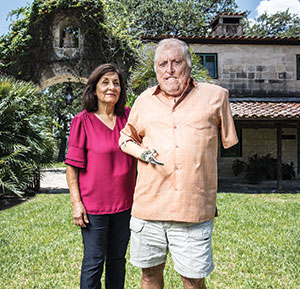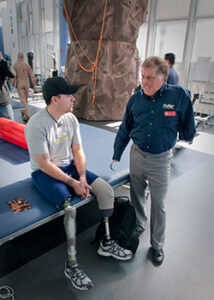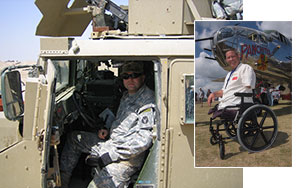 Bobby Barrera’s memories of recovering at the burn ward at Brooke Army Medical Center (BAMC) in San Antonio include waves of searing pain, the fogginess of sedation and the realization that medical staff had brought him back to life multiple times.
Bobby Barrera’s memories of recovering at the burn ward at Brooke Army Medical Center (BAMC) in San Antonio include waves of searing pain, the fogginess of sedation and the realization that medical staff had brought him back to life multiple times.
“[Before that] I was living my dream to serve in combat,” Barrera said of his time as a Marine. But after only six weeks in Vietnam, he was severely injured in an ambush on Sept. 16, 1969. He lost both arms and was burned over 40% of his body.
“They didn’t know if I would survive or not,” he said.
Barrera defied the odds and dedicated his life to improving the lives of other veterans. He began as a social worker helping military families. He was named the 1998 Disabled American Veteran of the Year, and in 2009, he served as DAV national commander.
As commander, he mentored wounded service members returning from Iraq and Afghanistan, including those at BAMC.

“I remember one young serviceman wearing the protective mask of someone who had experienced severe burns to his face. I know exactly what he was experiencing—the uncertainty, the pain,” Barrera said. “I hope I could provide him comfort just by being someone who had been there 30 years before and had gone on to have a family and a career.”
Now a motivational speaker for the Department of Veterans Affairs (VA), Barrera understands the hardships Vietnam War veterans faced at a time when the country didn’t fully grasp the repercussions of war. Given public sentiment toward Vietnam, veterans were often left to fend for themselves.
In turn, veterans like Barrera fought to improve care for future generations, providing community, mentorship and leadership. They influenced advancements in benefits and health care that continue to serve future veterans.
After Vietnam, many service members experienced flashbacks, distressing memories and crippling anxiety, leading to isolation, depression and suicidal thoughts. Recognizing this crisis, DAV funded the Forgotten Warrior Project in 1977. Conducted by Vietnam combat veteran and psychologist Dr. James Goodwin, it studied over 400 veterans, revealing high degrees of mistrust, anxiety, shame, survivor’s guilt and despair.
“They have a deep-seated conviction that nothing matters anymore, that they are helpless against the external forces of fate,” Goodwin wrote.
The project spurred DAV’s Vietnam Veterans Outreach Program, which later inspired the VA’s Vet Centers, community-based counseling centers that provide a wide range of social and psychological services, including professional readjustment counseling to eligible veterans, service members and their families.
Perhaps the most significant outcome was the introduction of post-traumatic stress disorder (PTSD) to the Diagnostic and Statistical Manual of Mental Disorders (DSM III), leading to the disorder being codified as a disability by the VA.

As a veteran who suffered from PTSD after serving in Iraq, Butch Whitehead is grateful to Vietnam-era veterans who fought for future generations.
“The Forgotten Warrior Project propelled PTSD treatment in veterans, leading to VA programs like the Vet Centers and the Veteran Crisis Line,” said Whitehead, DAV’s first post-9/11 national commander. “What these Vietnam veterans endured has saved countless lives from my generation of service and beyond.”
Whitehead was mentored by Vietnam veteran and triple amputee Jim Sursely, who served as DAV national commander.
“He was more than a fellow soldier and Minnesota native. He was an inspiration and a friend,” Whitehead said. “I count myself one of dozens—maybe hundreds—of post-9/11 veterans Jim influenced.”
Karen Owoc, a clinical exercise physiologist at the Palo Alto VA Medical Center in California, noted that PTSD remains prevalent among Vietnam and post-9/11 veterans.
“The nightmares, the PTSD—it’s still really prevalent,” Owoc said. “Sometimes I’m the only contact they have all week. That’s the challenge they face. They feel lonely.”
Loneliness can lead to depression, anxiety, substance abuse or suicidal ideations, with physical side effects as well.
“There’s a clear association between depression and heart disease,” she added.
Vietnam veterans also struggle with illnesses caused by Agent Orange exposure. The herbicide was sprayed to remove enemy cover, exposing millions of veterans to toxic chemicals. Related health conditions include respiratory issues, diabetes, hypertension, heart disease, Parkinson’s disease, neuropathy and various cancers.
The Agent Orange Act of 1991 established presumptive service connection for affected veterans, laying the foundation for toxic-exposure legislation, including the historic PACT Act of 2022.
DAV Chief Communications Officer Dan Clare, who deployed to Iraq in 2006, saw a memo detailing burn pit dangers. Knowing Vietnam veterans had fought for Agent Orange recognition, Clare leaked the memo to ensure Iraq and Afghanistan veterans wouldn’t face the same delays in care.
“At the time, DAV was led by Vietnam veterans, and they immediately connected burn pits and Agent Orange,” Clare said. “They had developed a playbook on presumptives from years of being underserved and fighting similar battles. DAV’s registry, when we first started getting calls, was the forerunner to the VA’s registry.”
One of those leaders Clare learned from was David Gorman, a benefits advocate who had risen to the level of executive director at DAV Washington Headquarters by the time Clare began his DAV career.
Gorman said that, in addition to the Forgotten Warrior Project and the Vet Centers, there were countless innovations paid for by the hardship and suffering of Vietnam veterans—including prosthetics innovation. Gorman, who lost both legs while serving as a combat engineer in Vietnam, saw VA rehabilitation evolve dramatically.
“It’s night and day,” Gorman said. “That’s one of the untold accomplishments of Vietnam veterans.”
He recalled his first wooden prostheses: “I wore a belt with suspenders to hold them on. Today, you get a computer-assisted prosthesis.”
More than 1,500 amputees injured since 9/11 owe gratitude to Vietnam veterans like Danny Werner, who helped the VA improve prosthetics technology until his death in 2024. Werner, a below-the-knee amputee, was a pioneer in neural-connected prosthetics.
“I knew I might not benefit from all this,” Werner said. “But somebody down the road will, and that’s why I do it.”
Barrera also found his initial experience with prostheses to be challenging. “Accepting that I had to learn how to do everything over, this time with prosthetics, was the hardest part for me,” he said. Barrera remembers that throughout his recovery, strangers visited to offer kindness. He found strength through what he calls the “four S’s of hope”: support, sense of humor, spirituality, and self-belief. The kindness he received inspired him to give back.
“Some nurses asked me to talk to struggling patients,” he said. “Later, I realized that’s where my counseling career started.”
Owoc encourages her patients to build community by helping others, as Vietnam veterans have done.
“Helping others makes you feel better,” she said. “That’s a therapeutic opportunity.”
Vietnam veterans didn’t return to a support network, but through DAV and leaders like Barrera and Gorman, they fought to ensure future generations would never be left behind. They exemplify the power of veterans helping veterans.
Gorman echoes this sentiment: “People help you along the way, and then you help someone else. That’s what DAV has always been.”
The post Clearing the path to healing for future generations appeared first on DAV.

